Pre Rata – Godine koje su dovele do početka rata između savezničkih i sila Osovine, bile su burne za ljude širom sveta. Velika depresija je počela deceniju pre, ostavljajući veliki deo sveta nezapošljenim i očajnim. Nacionalizam je zahvatio Nemačku negodujući protiv kaznenih mera Versajskog ugovora kojima je okončan Prvi svetski rat. Kina i Japansko carstvo su bili u ratu od japanske invazije Mandžurije 1931. godine. Nemačaka, Italija i Japan su testirali novoosnovanu Ligu Naroda sa više invazija i okupacija susednih zemalja i bile su ohrabrene time što nisu snosile nikakve posledice. Španski građanski rat koji je počeo 1936. godine bio je neka vrsta probe za predstojeći svetski – Nemačka i Italija su podržale nacionalističke pobunjenike pod vođstvom generala Franciska Franka a oko 40.000 stranih državljana je pohrlilo u Španiju da se bore za ono što bi sprečilo dalje širenje fašizma. U poslednjih nekoliko predratnih godina Nemačkoj se otvara put ka istom – naoružavanje, potpisivanje Pakta o nenapadanju sa Sovjetskim Savezom, aneksija Austrije i invazija Čehoslovačke. U međuvremenu su Sjedinjene Američke Države grčevito pokušavale putem akata o neutralnosti da ne budu uhvaćene u zamku sukoba s obzirom da se još uvek nisu oporavile od posledica Velike depresije. Ispod su fotografije koje su samo uvid u neki od tih događaja koji su doveli do Drugog svetskog rata.
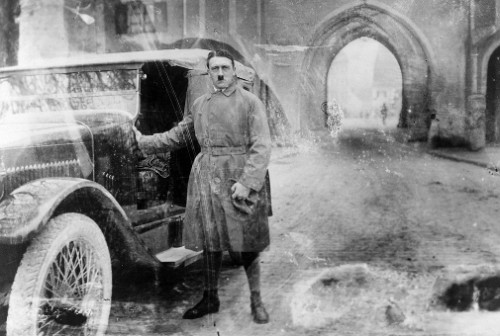 Adolf Hitler, age 35, on his release from Landesberg Prison, on December 20, 1924. Hitler had been convicted of treason for his role in an attempted coup in 1923 called the Beer Hall Putsch. This photograph was taken shortly after he finished dictating “Mein Kampf” to deputy Rudolf Hess. Eight years later, Hitler would be sworn in as Chancellor of Germany, in 1933.
Adolf Hitler, age 35, on his release from Landesberg Prison, on December 20, 1924. Hitler had been convicted of treason for his role in an attempted coup in 1923 called the Beer Hall Putsch. This photograph was taken shortly after he finished dictating “Mein Kampf” to deputy Rudolf Hess. Eight years later, Hitler would be sworn in as Chancellor of Germany, in 1933.
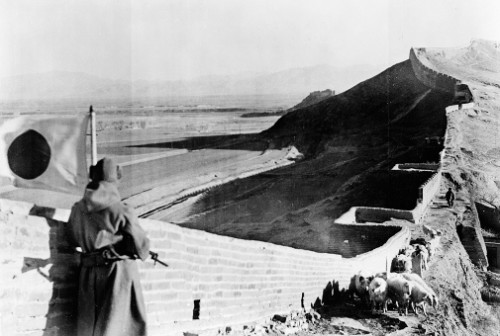 A Japanese soldier stands guard over part of the captured Great Wall of China in 1937, during the Second Sino-Japanese War. The Empire of Japan and the Republic of China had been at war intermittently since 1931, but the conflict escalated in 1937. (LOC)
A Japanese soldier stands guard over part of the captured Great Wall of China in 1937, during the Second Sino-Japanese War. The Empire of Japan and the Republic of China had been at war intermittently since 1931, but the conflict escalated in 1937. (LOC)
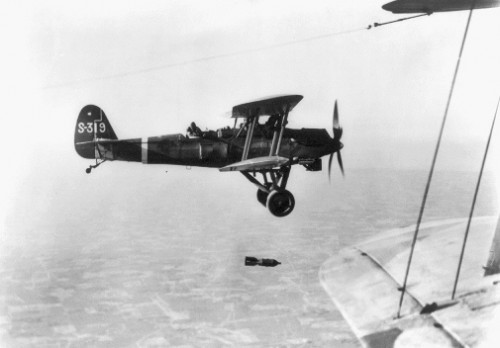 Japanese aircraft carry out a bombing run over targets in China in 1937. (LOC)
Japanese aircraft carry out a bombing run over targets in China in 1937. (LOC)
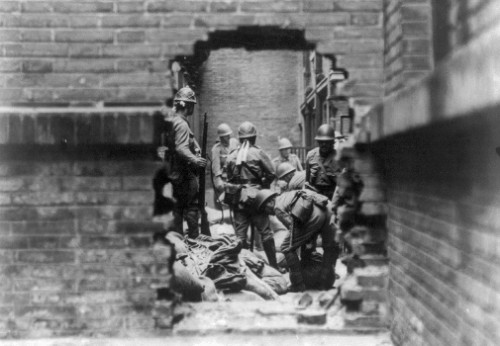 Japanese soldiers involved in street fighting in Shanghai, China in 1937. The battle of Shanghai lasted from August through November of 1937, eventually involving nearly one million troops. In the end, Shanghai fell to the Japanese, after over 150,000 casualties combined.(LOC)
Japanese soldiers involved in street fighting in Shanghai, China in 1937. The battle of Shanghai lasted from August through November of 1937, eventually involving nearly one million troops. In the end, Shanghai fell to the Japanese, after over 150,000 casualties combined.(LOC)
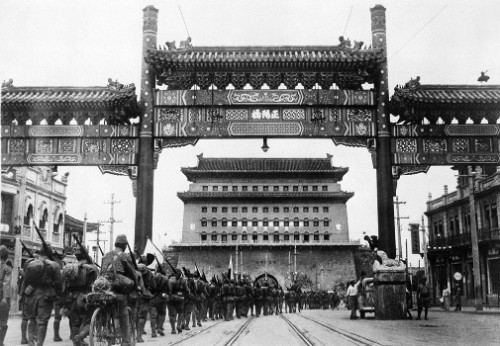 First pictures of the Japanese occupation of Peiping (Beijing) in China, on August 13, 1937. Under the banner of the rising sun, Japanese troops are shown passing from the Chinese City of Peiping into the Tartar City through Chen-men, the main gate leading onward to the palaces in the Forbidden City. Just a stone’s throw away is the American Embassy, where American residents of Peiping flocked when Sino-Japanese hostilities were at their worst. (AP Photo)
First pictures of the Japanese occupation of Peiping (Beijing) in China, on August 13, 1937. Under the banner of the rising sun, Japanese troops are shown passing from the Chinese City of Peiping into the Tartar City through Chen-men, the main gate leading onward to the palaces in the Forbidden City. Just a stone’s throw away is the American Embassy, where American residents of Peiping flocked when Sino-Japanese hostilities were at their worst. (AP Photo)
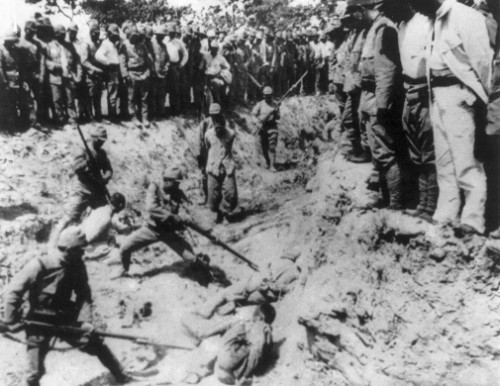 Japanese soldiers execute captured Chinese soldiers with bayonets in a trench as other Japanese soldiers watch from rim. (LOC)
Japanese soldiers execute captured Chinese soldiers with bayonets in a trench as other Japanese soldiers watch from rim. (LOC)
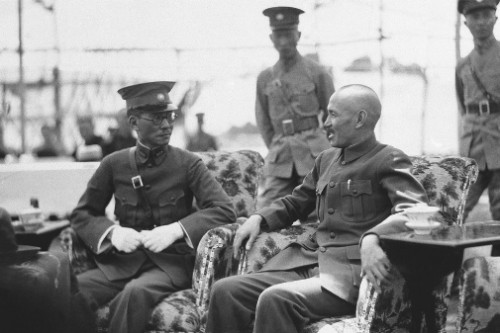 Chinese General Chiang Kai-shek, right, head of the Nanking government at Canton, with General Lung Yun, chairman of the Yunan provincial government in Nanking, on June 27, 1936. (AP Photo)
Chinese General Chiang Kai-shek, right, head of the Nanking government at Canton, with General Lung Yun, chairman of the Yunan provincial government in Nanking, on June 27, 1936. (AP Photo)
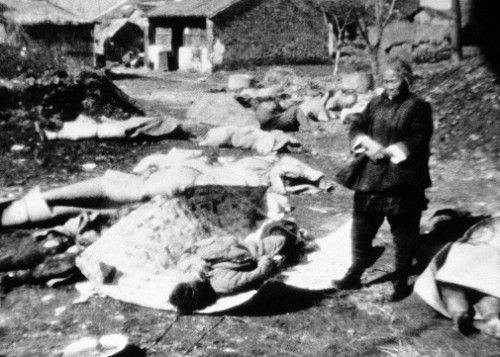 On Feb. 5, 1938, A Chinese woman surveys the remains of her family, all of whom met death during Japanese occupation of Nanking, allegedly victims of atrocities at the hands of Japanese soldiers. (AP Photo)
On Feb. 5, 1938, A Chinese woman surveys the remains of her family, all of whom met death during Japanese occupation of Nanking, allegedly victims of atrocities at the hands of Japanese soldiers. (AP Photo)
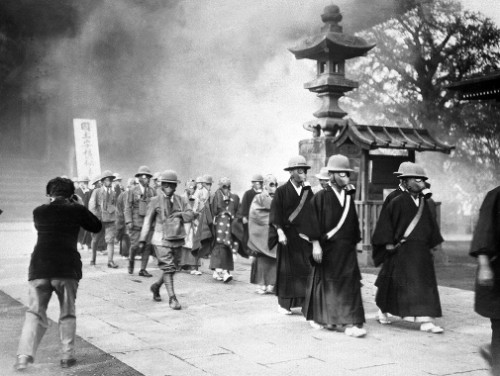 Buddhist priests of the Big Asakusa Temple prepare for the Second Sino-Japanese War as they wear gas masks during training against future aerial attacks in Tokyo, Japan, on May 30, 1936. (AP Photo)
Buddhist priests of the Big Asakusa Temple prepare for the Second Sino-Japanese War as they wear gas masks during training against future aerial attacks in Tokyo, Japan, on May 30, 1936. (AP Photo)
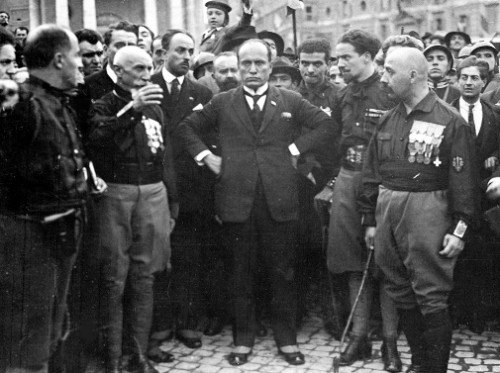 Italian Fascist leader Benito Mussolini, center, hands on hips, with members of the fascist Party, in Rome, Italy, Oct. 28, 1922, following their March on Rome. This march was an act of intimidation, where thousands of fascist blackshirts occupied strategic positions throughout much of Italy. Following the march, King Emanuelle III asked Mussolini to form a new government, clearing the way towards a dictatorship. (AP Photo)
Italian Fascist leader Benito Mussolini, center, hands on hips, with members of the fascist Party, in Rome, Italy, Oct. 28, 1922, following their March on Rome. This march was an act of intimidation, where thousands of fascist blackshirts occupied strategic positions throughout much of Italy. Following the march, King Emanuelle III asked Mussolini to form a new government, clearing the way towards a dictatorship. (AP Photo)
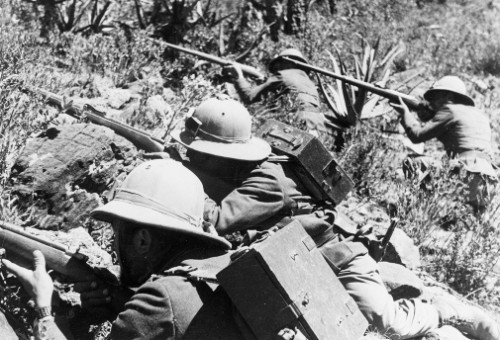 Four Italian soldiers taking aim in Ethiopia in 1935, during the Second Italo-Abyssinian War. Italian forces under Mussolini invaded and annexed Ethiopia, folding it into a colony named Italian East Africa along with Eritrea. (LOC)
Four Italian soldiers taking aim in Ethiopia in 1935, during the Second Italo-Abyssinian War. Italian forces under Mussolini invaded and annexed Ethiopia, folding it into a colony named Italian East Africa along with Eritrea. (LOC)
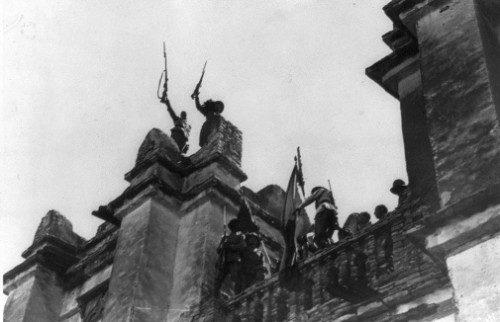 Italian troops raise the Italian flag over Macalle, Ethiopia in 1935. Emperor Haile Selassie’s appeals the the League of Nations for help went unanswered, and Italy was largely given a free hand to do as it pleased in East Africa. (LOC)
Italian troops raise the Italian flag over Macalle, Ethiopia in 1935. Emperor Haile Selassie’s appeals the the League of Nations for help went unanswered, and Italy was largely given a free hand to do as it pleased in East Africa. (LOC)
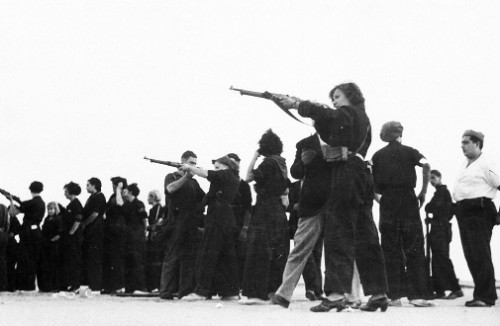 In Spain, loyalist soldiers teach target practice to women who are learning to defend the city of Barcelona against fascist rebel troops of general Francisco Franco during the Spanish Civil War, on June 2, 1937. (AP Photo)
In Spain, loyalist soldiers teach target practice to women who are learning to defend the city of Barcelona against fascist rebel troops of general Francisco Franco during the Spanish Civil War, on June 2, 1937. (AP Photo)
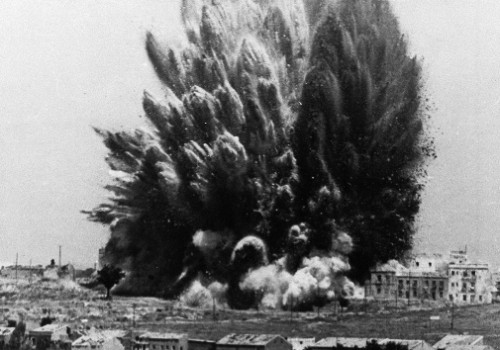 Three hundred fascist insurgents were killed in this explosion in Madrid, Spain, under the five-story Casa Blanca building, on March 19, 1938. Government loyalists tunneled 600 yards over a six-month period to lay the land mine that caused the explosion. (AP Photo)
Three hundred fascist insurgents were killed in this explosion in Madrid, Spain, under the five-story Casa Blanca building, on March 19, 1938. Government loyalists tunneled 600 yards over a six-month period to lay the land mine that caused the explosion. (AP Photo)
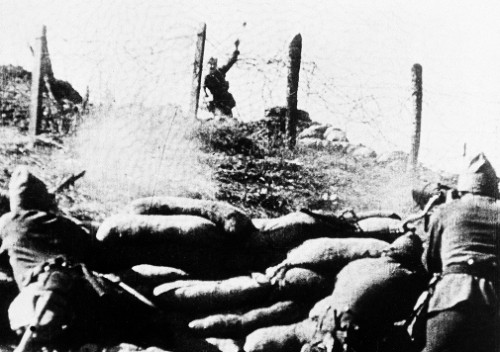 An insurgent fighter tosses a hand grenade over a barbed wire fence and into loyalist soldiers with machine guns blazing in Burgos, Spain, on Sept. 12, 1936. (AP Photo)
An insurgent fighter tosses a hand grenade over a barbed wire fence and into loyalist soldiers with machine guns blazing in Burgos, Spain, on Sept. 12, 1936. (AP Photo)
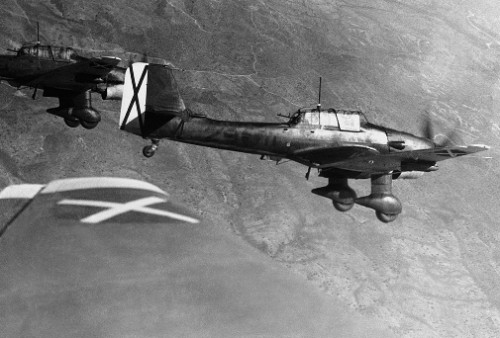 German-made Stuka dive bombers, part of the Condor Legion, in flight above Spain on May 30, 1939, during the Spanish Civil War. The black-and-white “X” on the tail and wings is Saint Andrew’s Cross, the insignia of Franco’s Nationalist Air Force. The Condor Legion was composed of volunteers from the German Army and Air Force. (AP Photo)
German-made Stuka dive bombers, part of the Condor Legion, in flight above Spain on May 30, 1939, during the Spanish Civil War. The black-and-white “X” on the tail and wings is Saint Andrew’s Cross, the insignia of Franco’s Nationalist Air Force. The Condor Legion was composed of volunteers from the German Army and Air Force. (AP Photo)
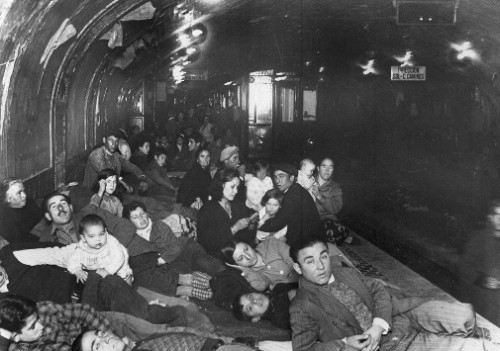 Scores of families are seen taking refuge underground on a Madrid subway platform, on Dec. 9, 1936, as bombs are dropped by Franco’s rebel aircraft overhead. (AP Photo)
Scores of families are seen taking refuge underground on a Madrid subway platform, on Dec. 9, 1936, as bombs are dropped by Franco’s rebel aircraft overhead. (AP Photo)
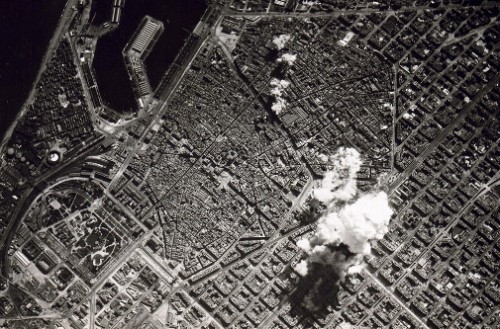 Aerial bombing of Barcelona in 1938 by Franco’s Nationalist Air Force. The Spanish Civil War saw some of the earliest extensive use of aerial bombardment of civilian targets, and the development of new terror bombing techniques. (Italian Airforce)
Aerial bombing of Barcelona in 1938 by Franco’s Nationalist Air Force. The Spanish Civil War saw some of the earliest extensive use of aerial bombardment of civilian targets, and the development of new terror bombing techniques. (Italian Airforce)
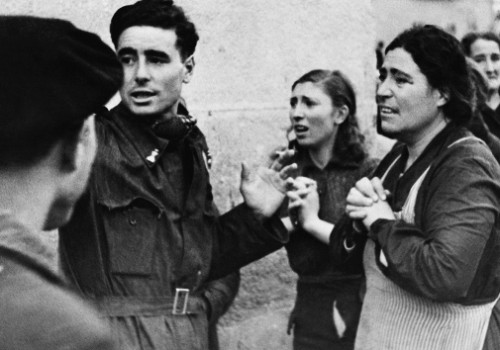 Following an aerial attack on Madrid from 16 rebel planes from Tetuan, Spanish Morocco, relatives of those trapped in ruined houses appeal for news of their loved ones, Jan. 8, 1937. The faces of these women reflect the horror non-combatants are suffering in the civil struggle. (AP Photo)
Following an aerial attack on Madrid from 16 rebel planes from Tetuan, Spanish Morocco, relatives of those trapped in ruined houses appeal for news of their loved ones, Jan. 8, 1937. The faces of these women reflect the horror non-combatants are suffering in the civil struggle. (AP Photo)
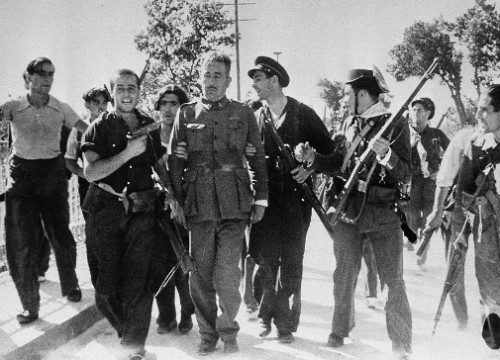 A Spanish rebel who surrendered is led to a summary court martial, as popular front volunteers and civil guards jeer, July 27, 1936, in Madrid, Spain. (AP Photo)
A Spanish rebel who surrendered is led to a summary court martial, as popular front volunteers and civil guards jeer, July 27, 1936, in Madrid, Spain. (AP Photo)
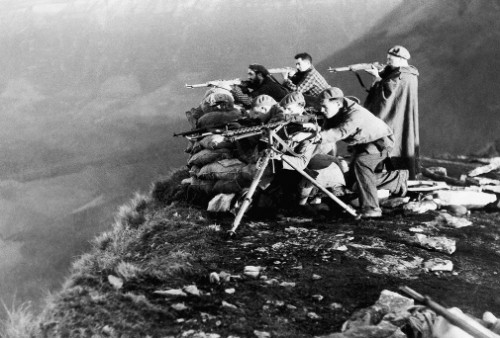 A fascist machine gun squad, backed up by expert riflemen, hold a position along the rugged Huesca front in northern Spain, Dec. 30, 1936. (AP Photo)
A fascist machine gun squad, backed up by expert riflemen, hold a position along the rugged Huesca front in northern Spain, Dec. 30, 1936. (AP Photo)
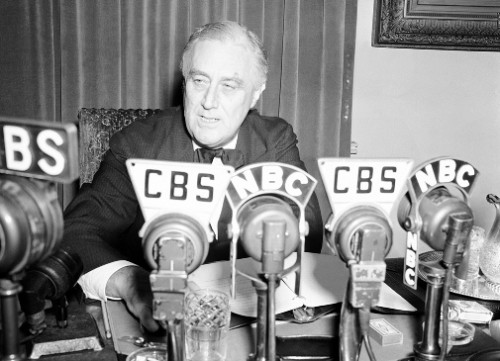 Solemnly promising the nation his utmost effort to keep the country neutral, U.S. President Franklin D. Roosevelt is shown as he addressed the nation by radio from the White House in Washington, Sept. 3, 1939. In the years leading up to the war, the U.S. Congress passed several Neutrality Acts, pledging to stay (officially) out of the conflict. (AP Photo)
Solemnly promising the nation his utmost effort to keep the country neutral, U.S. President Franklin D. Roosevelt is shown as he addressed the nation by radio from the White House in Washington, Sept. 3, 1939. In the years leading up to the war, the U.S. Congress passed several Neutrality Acts, pledging to stay (officially) out of the conflict. (AP Photo)
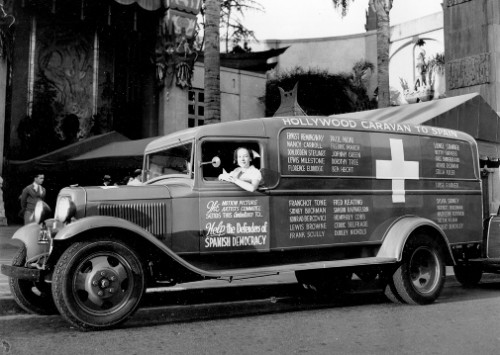 Riette Kahn is shown at the wheel of an ambulance donated by the American movie industry to the Spanish government in Los Angeles, California, on Sept. 18, 1937. The Hollywood Caravan to Spain will first tour the U.S. to raise funds to “help the defenders of Spanish democracy” in the Spanish Civil War. (AP Photo)
Riette Kahn is shown at the wheel of an ambulance donated by the American movie industry to the Spanish government in Los Angeles, California, on Sept. 18, 1937. The Hollywood Caravan to Spain will first tour the U.S. to raise funds to “help the defenders of Spanish democracy” in the Spanish Civil War. (AP Photo)
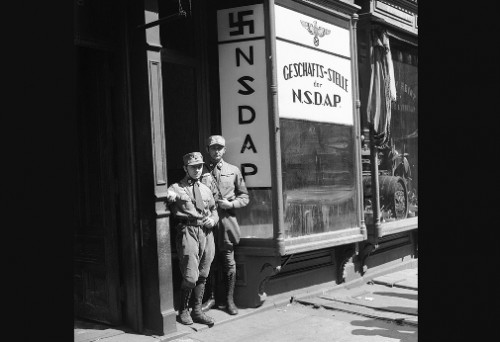 Two American Nazis in uniform stand in the doorway of their New York City office, on April 1, 1932, when the headquarters opened. “NSDAP” stands for Nationalsozialistische Deutsche Arbeiterpartei, or, in English, National Socialist German Workers’ Party, normally shortened to just “Nazi Party”. (AP Photo)
Two American Nazis in uniform stand in the doorway of their New York City office, on April 1, 1932, when the headquarters opened. “NSDAP” stands for Nationalsozialistische Deutsche Arbeiterpartei, or, in English, National Socialist German Workers’ Party, normally shortened to just “Nazi Party”. (AP Photo)
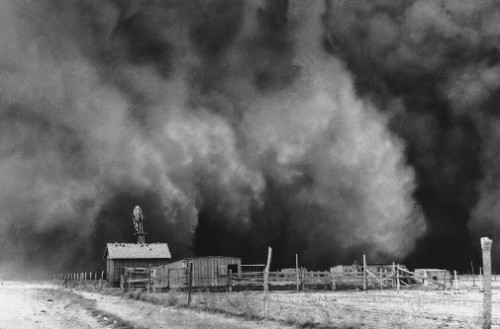 About to be engulfed in a gigantic dust cloud is a peaceful little ranch in Boise City, Oklahoma where the topsoil is being dried and blown away during the years of the Dust Bowl in central North America. Severe drought, poor farming techniques and devastating storms rendered millions of acres of farmland useless. This photo was taken on April 15, 1935. (AP Photo)
About to be engulfed in a gigantic dust cloud is a peaceful little ranch in Boise City, Oklahoma where the topsoil is being dried and blown away during the years of the Dust Bowl in central North America. Severe drought, poor farming techniques and devastating storms rendered millions of acres of farmland useless. This photo was taken on April 15, 1935. (AP Photo)
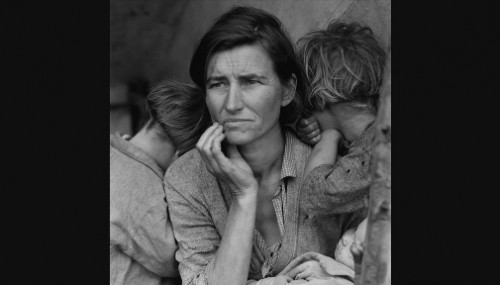 Florence Thompson with three of her children in a photograph known as “Migrant Mother.” This famous image is one of a series of photographs that photographer Dorothea Lange made of Florence Thompson and her children in early 1936 in Nipomo, California.
Florence Thompson with three of her children in a photograph known as “Migrant Mother.” This famous image is one of a series of photographs that photographer Dorothea Lange made of Florence Thompson and her children in early 1936 in Nipomo, California.
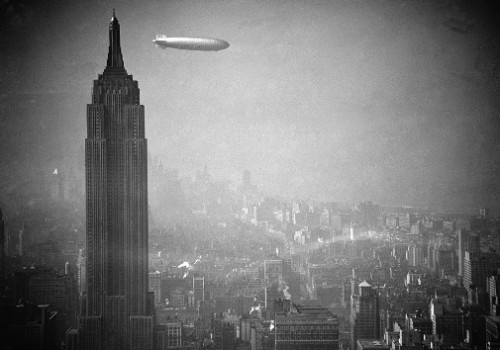 The zeppelin Hindenburg floats past the Empire State Building over Manhattan on Aug. 8, 1936. The German airship was en route to Lakehurst, New Jersey, from Germany. The Hindenburg would later explode in a spectacular fireball above Lakehurst on May 6, 1937.(AP Photo)
The zeppelin Hindenburg floats past the Empire State Building over Manhattan on Aug. 8, 1936. The German airship was en route to Lakehurst, New Jersey, from Germany. The Hindenburg would later explode in a spectacular fireball above Lakehurst on May 6, 1937.(AP Photo)
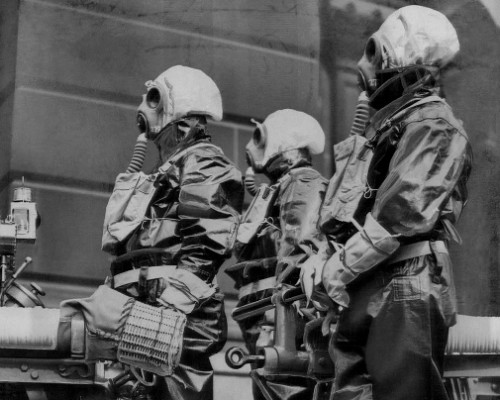 England’s biggest demonstration of its readiness to go through a gas attack was staged, March 16, 1938, when 2,000 volunteers in Birmingham donned gas masks and went through an elaborate drill. These three firemen were fully equipped, from rubber boots to masks, for the mock gas “invasion”. (AP Photo)
England’s biggest demonstration of its readiness to go through a gas attack was staged, March 16, 1938, when 2,000 volunteers in Birmingham donned gas masks and went through an elaborate drill. These three firemen were fully equipped, from rubber boots to masks, for the mock gas “invasion”. (AP Photo)
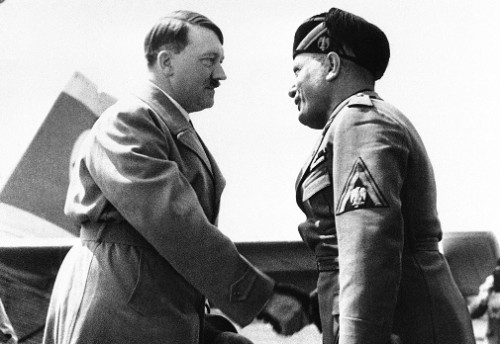 Adolf Hitler of Germany and Benito Mussolini of Italy greet each other as they meet at the airfield in Venice, Italy, on June 14, 1934. Mussolini and his fascists put on a show for Hitler, but on the details of their subsequent conversations there was little news.(AP Photo)
Adolf Hitler of Germany and Benito Mussolini of Italy greet each other as they meet at the airfield in Venice, Italy, on June 14, 1934. Mussolini and his fascists put on a show for Hitler, but on the details of their subsequent conversations there was little news.(AP Photo)
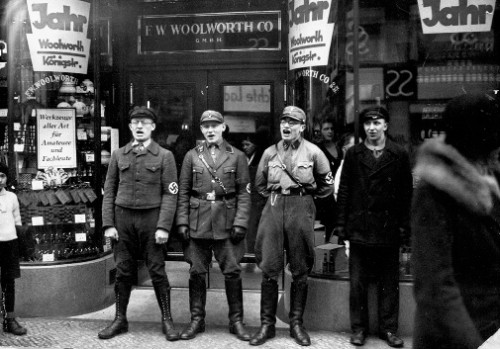 Four Nazi troops sing in front of the Berlin branch of the Woolworth Co. store during the movement to boycott Jewish presence in Germany, in March, 1933. The Hitlerites believe the founder of the Woolworth Co. was Jewish. (AP Photo)
Four Nazi troops sing in front of the Berlin branch of the Woolworth Co. store during the movement to boycott Jewish presence in Germany, in March, 1933. The Hitlerites believe the founder of the Woolworth Co. was Jewish. (AP Photo)
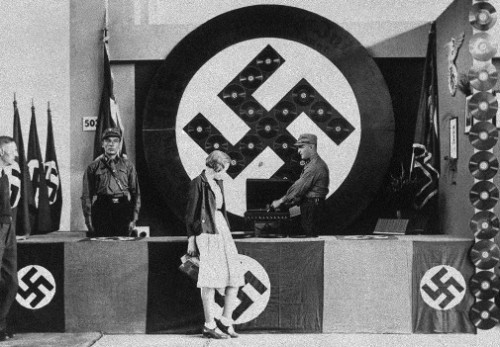 The Nazi booth at a radio exhibition which started in Berlin on August 19, 1932. The booth is designed as propaganda of the Nazi gramophone plate industry which produces only records of the national socialist movement. (AP Photo)
The Nazi booth at a radio exhibition which started in Berlin on August 19, 1932. The booth is designed as propaganda of the Nazi gramophone plate industry which produces only records of the national socialist movement. (AP Photo)
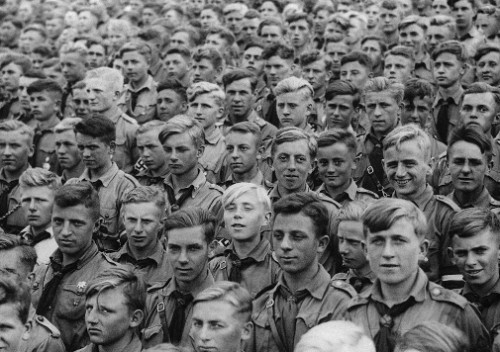 Thousands of young men flocked to hang upon the words of their leader, Reichsfuhrer Adolf Hitler, as he addressed the convention of the National Socialist Party in Nuremberg, Germany on Sept. 11, 1935. (AP Photo)
Thousands of young men flocked to hang upon the words of their leader, Reichsfuhrer Adolf Hitler, as he addressed the convention of the National Socialist Party in Nuremberg, Germany on Sept. 11, 1935. (AP Photo)
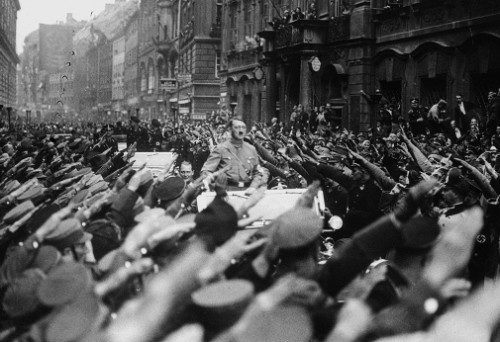 Adolf Hitler is shown being cheered as he rides through the streets of Munich, Germany, November 9, 1933, during the celebration of the 10th anniversary of the National Socialist movement. (AP Photo)
Adolf Hitler is shown being cheered as he rides through the streets of Munich, Germany, November 9, 1933, during the celebration of the 10th anniversary of the National Socialist movement. (AP Photo)
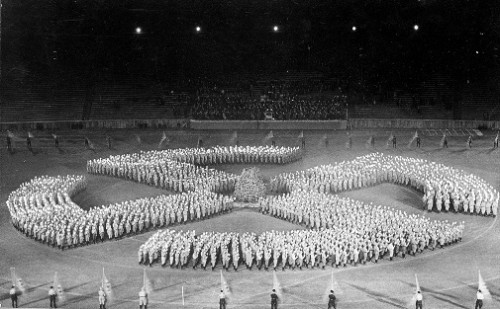 Hitler youth honor an unknown soldier by forming a swastika symbol on Aug. 27, 1933 in Germany. (AP Photo)
Hitler youth honor an unknown soldier by forming a swastika symbol on Aug. 27, 1933 in Germany. (AP Photo)
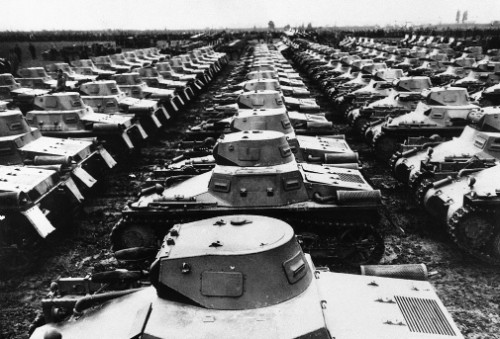 The German army demonstrated its might before more than a million residents during the nationwide harvest festival at Bückeburg, near Hanover, Germany, on Oct. 4, 1935. Here are scores of tanks lined up just before the demonstration began. Defying provisions of the Treaty of Versailles, Germany began rearming itself at a rapid rate shortly after Hitler came to power in 1933. (AP Photo)
The German army demonstrated its might before more than a million residents during the nationwide harvest festival at Bückeburg, near Hanover, Germany, on Oct. 4, 1935. Here are scores of tanks lined up just before the demonstration began. Defying provisions of the Treaty of Versailles, Germany began rearming itself at a rapid rate shortly after Hitler came to power in 1933. (AP Photo)
 Thousand of Germans participate in the Great National Socialistic meeting in Berlin, Germany, on July 9, 1932. (AP Photo)
Thousand of Germans participate in the Great National Socialistic meeting in Berlin, Germany, on July 9, 1932. (AP Photo)
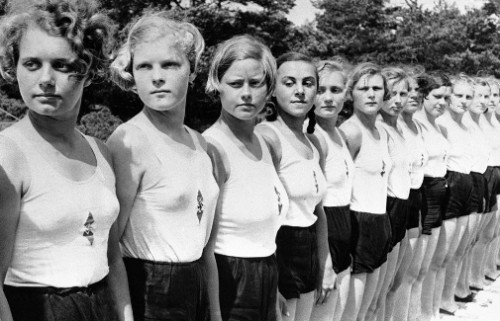 A group of German girls line up to learn musical culture under auspices of the Nazi Youth Movement, in Berlin, Germany on Feb. 24, 1936.(AP Photo)
A group of German girls line up to learn musical culture under auspices of the Nazi Youth Movement, in Berlin, Germany on Feb. 24, 1936.(AP Photo)
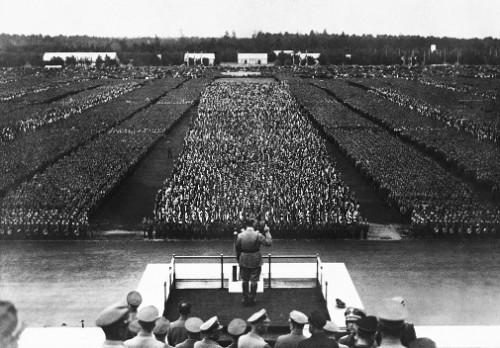 Hitler’s Nazi party convention, underway in Nuremberg, Germany, on Sept. 10, 1935. (AP Photo)
Hitler’s Nazi party convention, underway in Nuremberg, Germany, on Sept. 10, 1935. (AP Photo)
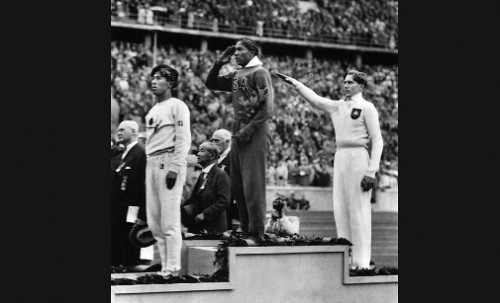 America’s Jesse Owens, center, salutes during the presentation of his gold medal for the long jump on August 11, 1936, after defeating Nazi Germany’s Lutz Long, right, during the 1936 Summer Olympics in Berlin. Naoto Tajima of Japan, left, placed third. Owens triumphed in the track and field competition by winning four gold medals in the 100-meter and 200-meter dashes, long jump and 400-meter relay. He was the first athlete to win four gold medals at a single Olympic Games. (AP Photo)
America’s Jesse Owens, center, salutes during the presentation of his gold medal for the long jump on August 11, 1936, after defeating Nazi Germany’s Lutz Long, right, during the 1936 Summer Olympics in Berlin. Naoto Tajima of Japan, left, placed third. Owens triumphed in the track and field competition by winning four gold medals in the 100-meter and 200-meter dashes, long jump and 400-meter relay. He was the first athlete to win four gold medals at a single Olympic Games. (AP Photo)
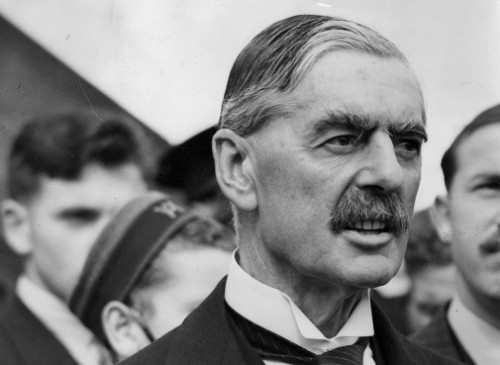 British Premier Sir Neville Chamberlain, on his return from talks with Hitler in Germany, at Heston airfield, London, England, on September 24, 1938. Chamberlain brought with him a terms of the plan later to be called the Munich Agreement, which, in an act of appeasment, allowed Germany to annex Czechoslovakia’s Sudetenland. (AP Photo/Pringle)
British Premier Sir Neville Chamberlain, on his return from talks with Hitler in Germany, at Heston airfield, London, England, on September 24, 1938. Chamberlain brought with him a terms of the plan later to be called the Munich Agreement, which, in an act of appeasment, allowed Germany to annex Czechoslovakia’s Sudetenland. (AP Photo/Pringle)
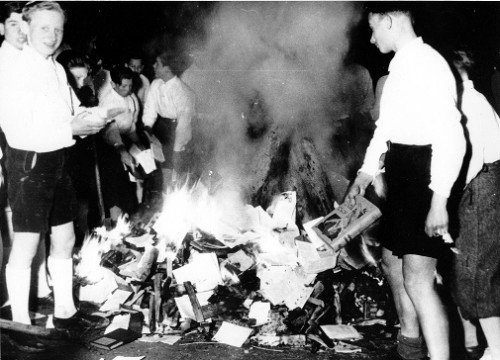 Members of the Nazi Youth participate in burning books, Buecherverbrennung, in Salzburg, Austria, on April 30, 1938. The public burning of books that were condemned as un-German, or Jewish-Marxist was a common activity in Nazi Germany. (AP Photo)
Members of the Nazi Youth participate in burning books, Buecherverbrennung, in Salzburg, Austria, on April 30, 1938. The public burning of books that were condemned as un-German, or Jewish-Marxist was a common activity in Nazi Germany. (AP Photo)
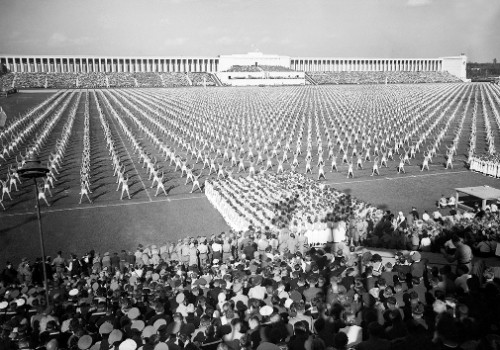 Mass gymnastics were the feature of the “Day of Community” at Nuremberg, Germany on September 8, 1938 and Adolf Hitler watched the huge demonstrations given on the Zeppelin Field. (AP Photo)
Mass gymnastics were the feature of the “Day of Community” at Nuremberg, Germany on September 8, 1938 and Adolf Hitler watched the huge demonstrations given on the Zeppelin Field. (AP Photo)
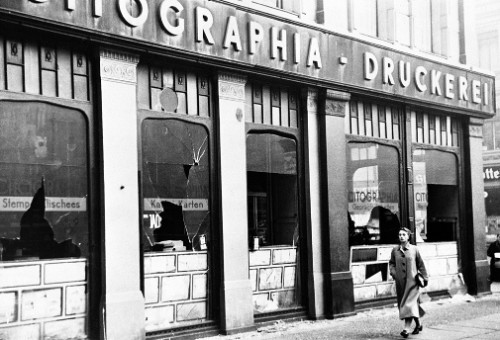 Windows of shops owned by Jews which were broken during a coordinated anti-Jewish demonstration in Berlin, known as Kristallnacht, on Nov. 10, 1938. Nazi authorities turned a blind eye as SA stormtroopers and civilians destroyed storefronts with hammers, leaving the streets covered in pieces of smashed windows. Ninety-one Jews were killed, and 30,000 Jewish men were taken to concentration camps.(AP Photo)
Windows of shops owned by Jews which were broken during a coordinated anti-Jewish demonstration in Berlin, known as Kristallnacht, on Nov. 10, 1938. Nazi authorities turned a blind eye as SA stormtroopers and civilians destroyed storefronts with hammers, leaving the streets covered in pieces of smashed windows. Ninety-one Jews were killed, and 30,000 Jewish men were taken to concentration camps.(AP Photo)
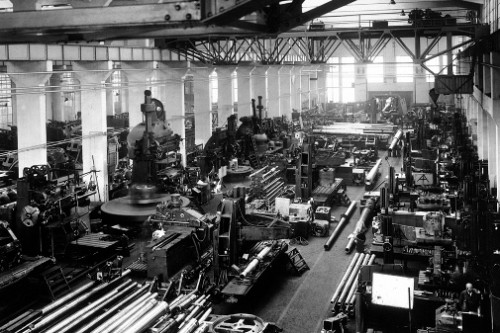 View of one of the large halls of the Rheinmetall-borsig Armament factories at Duesseldorf, Germany, on August 13, 1939, where gun barrels are the main output. Before the start of the war, German factories were cranking out pieces of military machinery measured in the hundreds per year. Soon it climbed into the tens of thousands. In 1944 alone, over 25,000 fighter planes were built. (AP Photo)
View of one of the large halls of the Rheinmetall-borsig Armament factories at Duesseldorf, Germany, on August 13, 1939, where gun barrels are the main output. Before the start of the war, German factories were cranking out pieces of military machinery measured in the hundreds per year. Soon it climbed into the tens of thousands. In 1944 alone, over 25,000 fighter planes were built. (AP Photo)
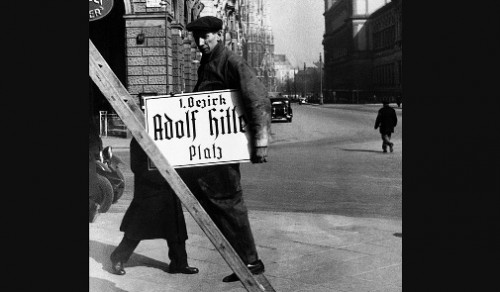 While newly-annexed Austria awaited the arrival of Adolf Hitler, preparations were underway. Streets were decorated and street names were changed. A workman in Vienna City square carries a new name plate for the square, renaming it “Adolf Hitler Place” on March 14, 1938. (AP Photo)
While newly-annexed Austria awaited the arrival of Adolf Hitler, preparations were underway. Streets were decorated and street names were changed. A workman in Vienna City square carries a new name plate for the square, renaming it “Adolf Hitler Place” on March 14, 1938. (AP Photo)

Izvrstan pregled!